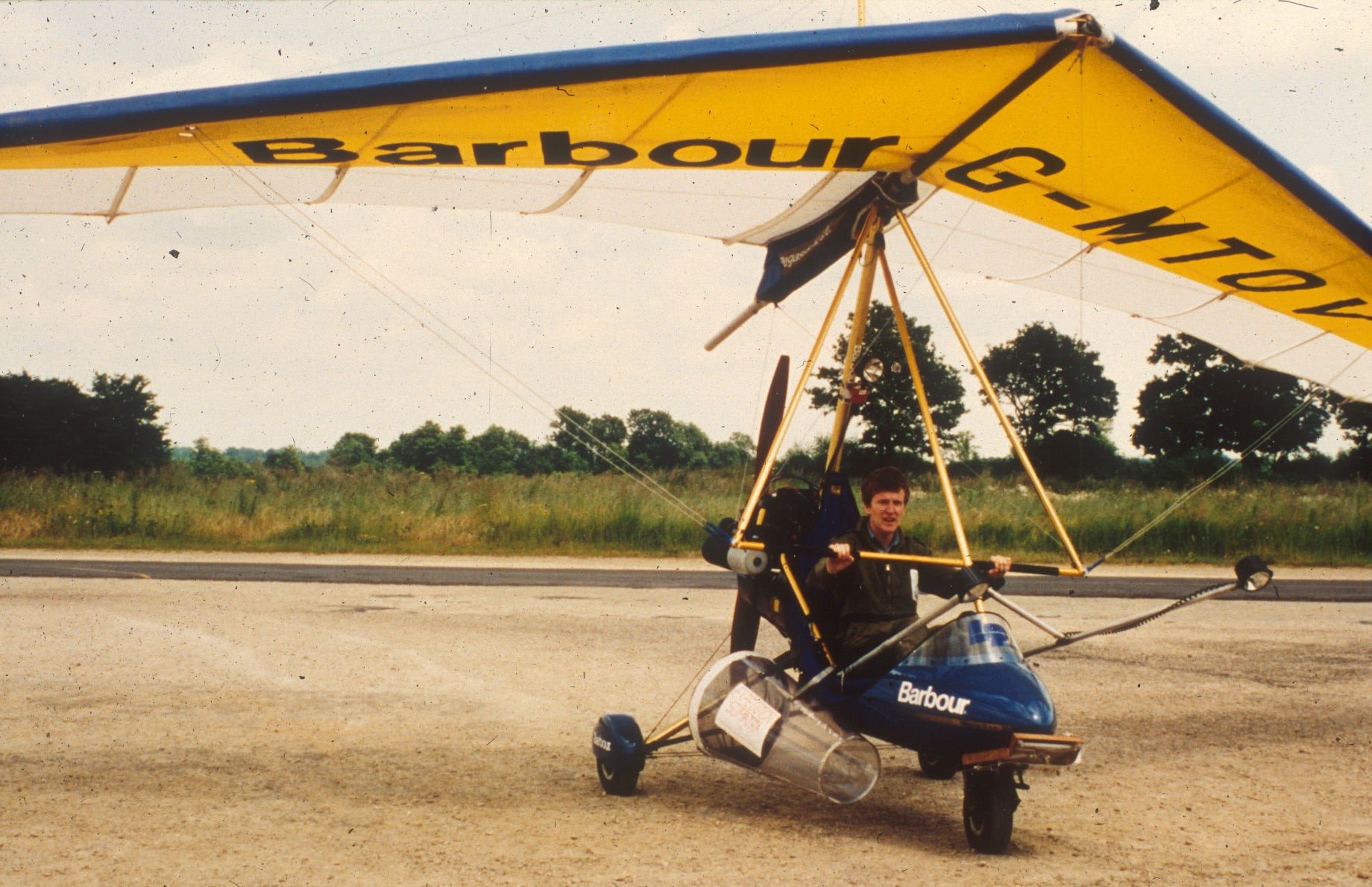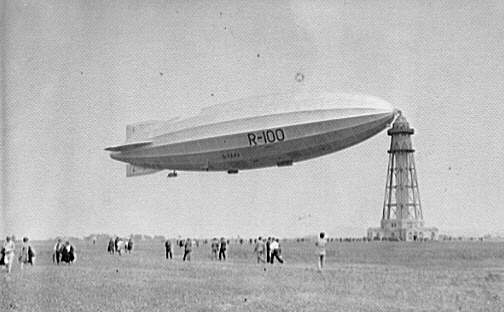|
Barnes Wallis Moth Machine
The Barnes Wallis Moth Machine was a modified microlight aircraft designed for collecting moths and other flying insects over rainforest canopies. The core machine was a Pegasus Q microlight aircraft. Modifications for moth catching were designed by Charles Cockell and implemented by a team of engineers at Enstone Airfield, UK. The machine was test flown in Oxford by Charles Cockell and then flown over the rainforest canopy in Sumatra, Indonesia in 1993 by Cockell in an effort to catch moths to catalog the diversity of moths in the rainforest as part of a biodiversity study of the Kerinci Seblat National Park. The machine had several modifications for moth catching: 1) Ultraviolet lights under the front of the aircraft for attracting moths during systematic sweeps of the forest, 2) A moth catching device consisting of an inverted funnel with a pleated butterfly net at the end for trapping moths scooped during flight, 3) A forward facing one million candlepower lamp to avoid trees ... [...More Info...] [...Related Items...] OR: [Wikipedia] [Google] [Baidu] |
Barnes Wallis Moth Machine
The Barnes Wallis Moth Machine was a modified microlight aircraft designed for collecting moths and other flying insects over rainforest canopies. The core machine was a Pegasus Q microlight aircraft. Modifications for moth catching were designed by Charles Cockell and implemented by a team of engineers at Enstone Airfield, UK. The machine was test flown in Oxford by Charles Cockell and then flown over the rainforest canopy in Sumatra, Indonesia in 1993 by Cockell in an effort to catch moths to catalog the diversity of moths in the rainforest as part of a biodiversity study of the Kerinci Seblat National Park. The machine had several modifications for moth catching: 1) Ultraviolet lights under the front of the aircraft for attracting moths during systematic sweeps of the forest, 2) A moth catching device consisting of an inverted funnel with a pleated butterfly net at the end for trapping moths scooped during flight, 3) A forward facing one million candlepower lamp to avoid trees ... [...More Info...] [...Related Items...] OR: [Wikipedia] [Google] [Baidu] |
Charles Cockell
Charles Cockell (born 21 May 1967) is a British astrobiologist who is professor of astrobiology in the School of Physics and Astronomy at the University of Edinburgh and co-director of the UK Centre for Astrobiology. Education Cockell received his undergraduate degree in biochemistry and molecular biology at the University of Bristol in 1989 and his D.Phil. in molecular biophysics, University of Oxford in 1994. Career Cockell was a National Research Council (National Academy of Sciences) Associate at the NASA Ames Research Center at Moffett Field from 1995 to 1998 and then a visiting scholar at Stanford University. He then worked at a microbiologist at the British Antarctic Survey, Cambridge, UK from 1999 to 2005, before becoming Professor of Geomicrobiology with the Open University until 2011 and afterwards moving to the University of Edinburgh as Professor of Astrobiology. His scientific interests have focused on astrobiology, geomicrobiology and life in extreme environme ... [...More Info...] [...Related Items...] OR: [Wikipedia] [Google] [Baidu] |
Kerinci Seblat National Park
Kerinci Seblat National Park is the largest national park on the island of Sumatra, Indonesia. It has a total area of 13,791 km2, and spans four provinces: West Sumatra, Jambi, Bengkulu, and South Sumatra. Geography It is located between 100°31'18"E - 102°44'01"E and 1°07'13"S - 3°26'14"S. The park area includes a large part of the Barisan mountain range, which form the western spine of Sumatra island and includes the highest peak in Sumatra, Mount Kerinci (3,805 m), one of more than five active volcanoes in the national park. This mainly montane park includes hot springs, rivers with rapids, caves, scenic waterfalls, and the highest caldera lake in Southeast Asia - Lake Gunung Tujuh, while the Great Sumatran fault runs through the national park making the area of great interest to geologists. The park completely encircles the populated Kerinci valley. Flora and fauna The park is home to diverse flora and fauna. Over 4,000 plant species have been identified to date i ... [...More Info...] [...Related Items...] OR: [Wikipedia] [Google] [Baidu] |
617 Squadron
Number 617 Squadron is a Royal Air Force aircraft squadron, originally based at RAF Scampton in Lincolnshire and currently based at RAF Marham in Norfolk. It is commonly known as "''The Dambusters''", for its actions during Operation Chastise against German dams during the Second World War. In the early 21st century it operated the Panavia Tornado GR4 in the ground attack and reconnaissance role until being disbanded on 28 March 2014. ''The Dambusters'' reformed on 18 April 2018, and was equipped at RAF Marham in June 2018 with the Lockheed Martin F-35B Lightning, becoming the first squadron to be based in the UK with this advanced V/STOL type. The unit is composed of both RAF and Royal Navy personnel, and operates from the Royal Navy's aircraft carriers. History Between the wars According to the squadron's entry in ''Flying Units of the RAF'' by Alan Lake, No. 617 Squadron was allocated the unit identification code MZ for the period April to September 1939, even though the u ... [...More Info...] [...Related Items...] OR: [Wikipedia] [Google] [Baidu] |
Barnes Wallis
Sir Barnes Neville Wallis (26 September 1887 – 30 October 1979) was an English engineer and inventor. He is best known for inventing the bouncing bomb used by the Royal Air Force in Operation Chastise (the "Dambusters" raid) to attack the dams of the Ruhr Valley during World War II. The raid was the subject of the 1955 film '' The Dam Busters'', in which Wallis was played by Michael Redgrave. Among his other inventions were his version of the geodetic airframe and the earthquake bomb. Early life and education Barnes Wallis was born in Ripley, Derbyshire, to Charles William George Robinson Wallis (1859–1945) and his wife Edith Eyre Wallis née Ashby (1859–1911). He was educated at Christ's Hospital in Horsham and Haberdashers' Aske's Hatcham Boys' Grammar School in southeast London, leaving school at seventeen to start work in January 1905 at Thames Engineering Works at Blackheath, southeast London. He subsequently changed his apprenticeship to J. Samuel White's ... [...More Info...] [...Related Items...] OR: [Wikipedia] [Google] [Baidu] |
Susannah York
Susannah Yolande Fletcher (9 January 1939 – 15 January 2011), known professionally as Susannah York, was an English actress. Her appearances in various films of the 1960s, including '' Tom Jones'' (1963) and '' They Shoot Horses, Don't They?'' (1969), formed the basis of her international reputation. An obituary in ''The Telegraph'' characterised her as "the blue-eyed English rose with the china-white skin and cupid lips who epitomised the sensuality of the swinging sixties", who later "proved that she was a real actor of extraordinary emotional range". York's early films included ''The Greengage Summer'' (1961) and ''Freud'' (1962). She received a nomination for the Academy Award for Best Supporting Actress for ''They Shoot Horses, Don't They?'' She also won the 1972 Cannes Film Festival Award for Best Actress for ''Images''. Her other film appearances included ''Sands of the Kalahari'' (1965), '' A Man for All Seasons'' (1966), ''The Killing of Sister George'' (1968), ''Batt ... [...More Info...] [...Related Items...] OR: [Wikipedia] [Google] [Baidu] |
David Bellamy
David James Bellamy (18 January 1933 – 11 December 2019) was an English botanist, television presenter, author and environmental campaigner. Early and personal life Bellamy was born in London to parents Winifred May (née Green) and Thomas Bellamy on 18 January 1933. He was raised in a Baptist family and retained a strong Christian faith throughout his life. As a child, he had hoped to be a ballet dancer, but he concluded that his rather large physique regrettably precluded him from pursuing the training. Bellamy went to school in south London, attending Chatsworth Road Primary School in Cheam, Cheam Road Junior School, and Sutton County Grammar School, where he initially showed an aptitude for English literature and history; he then found his vocation because of an inspirational science teacher, studying zoology, botany, physics, and chemistry in the sixth form. He gained an honours degree in botany at Chelsea College of Science and Technology (now part of King's College ... [...More Info...] [...Related Items...] OR: [Wikipedia] [Google] [Baidu] |



_trailer.jpg)